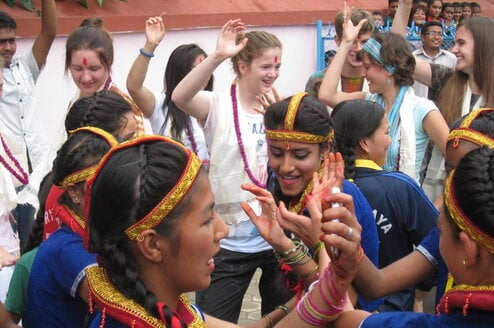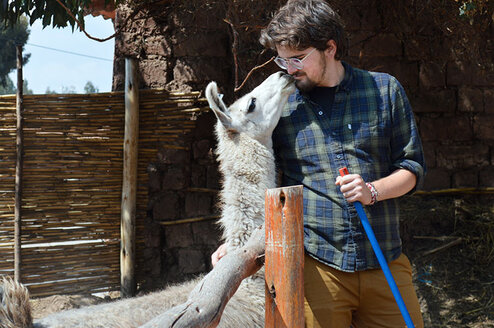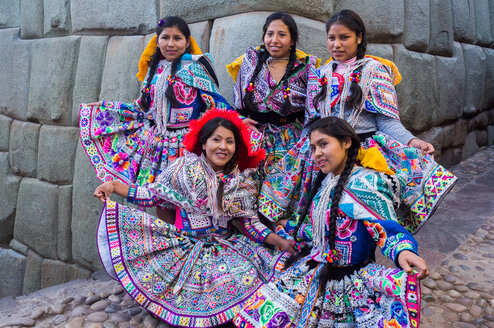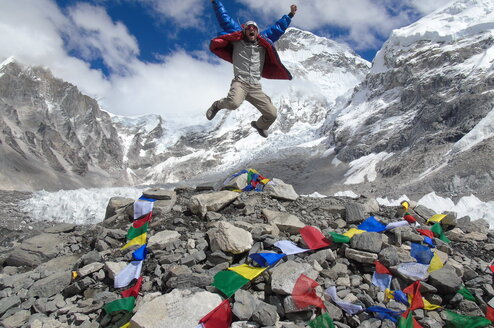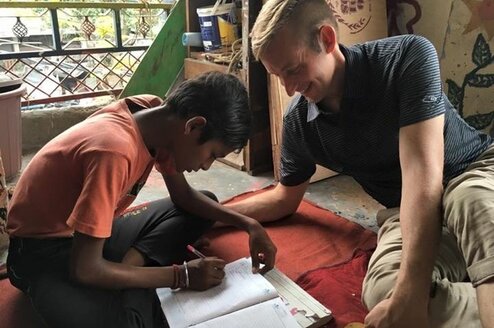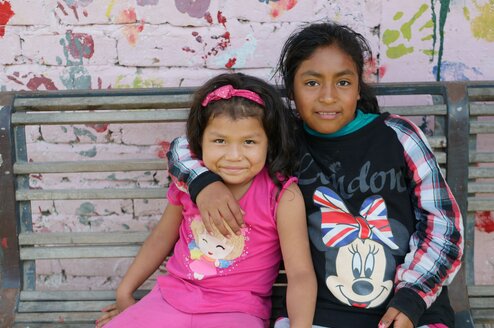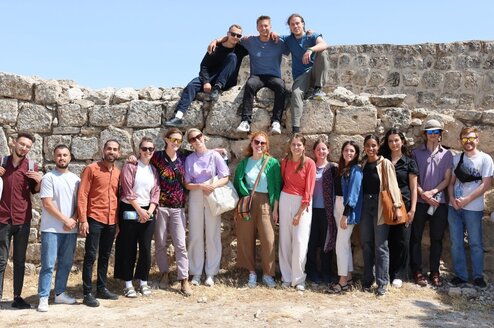Disaster Relief Volunteer Abroad Programs
Disaster Relief Programs
Pagination
About
One of the most unpredictable, and many times most devastating, things to happen to a country is a natural disaster. Regardless of a country’s economic or political standing, natural disasters can wreak havoc on a population causing an infinitely long recovery process.
Each scenario is different, but these situations often call for volunteers with a variety of backgrounds to help physically and emotionally rebuild affected communities. Regardless of the particular skillset and background you bring to the table, there’s a good chance you have something to offer in volunteering abroad in an area affected by a natural disaster.
- Looking to help with the bushfire efforts? Volunteer in Australia
- Looking to help with earthquake disaster relief? Volunteer in Puerto Rico
Program Types
There are countless ways to get involved in volunteer projects abroad as a means of aiding countries suffering from both natural and man-made disasters. Sometimes, the unpredictability of these phenomena can create an urgent need in a particular area. That means that volunteers are often required to have the ability to leave on a moment’s notice.
Other times, a region has been suffering and/or recovering from a disaster for many years. What makes disasters so disastrous is often their wide-scale consequences, including things like destruction of homes, hunger, and spread of disease.
This means that countless types of volunteers and skillsets can be valuable for these types of projects. Take a look at a few of the common types of volunteering activities and projects aimed at disaster relief around the world.
Rebuilding of Homes and Infrastructure:
Rebuilding of homes and infrastructures is often the most common image that comes to mind when one thinks of disaster relief. It's true that large-scale devastation usually comes with loss of home, but something like a storm that lasts less than a day can lead to countless years of rebuilding. Be it a natural disaster or a man-made catastrophe, permanent homes in affected regions take a lot of time, resources, and money to rebuild.
Medical Relief:
Medical relief is also an often crucial component of emergency relief. These types of positions typically require people with some experience and training in this field, but they don’t always require you to be a medical doctor. There are also many opportunities for pre-med students, nurses, etc. Some of these volunteer experiences may deal with things like the ongoing spread of disease due to a disaster in a certain area, with more of a focus on prevention.
School Construction/ Educational Assistance:
Some areas are in need of volunteers to help with creating schools or educating students affected by a natural or man-made disaster. Again, the experience required of volunteers will vary, and the lengths of the programs are definitely dependent on the situation.
Photo credits: Possible Health.
Popular Destinations
No region of the world is immune to disasters, be them natural or man-made. Some countries are better equipped than others to try to appropriately prepare and/or respond when disasters strike, but even the wealthiest and most developed nations can feel the consequences of an unpredicted catastrophe. Here are just a couple examples of some regions where outside disaster relief is needed most.
Drought-Stricken Areas (East Africa):
In 2011, the region of East Africa faced its worst drought in almost 60 years, and it affected more than 10 million people. Many organizations provided emergency response in the form of collecting funds and facilitating relief and rehabilitation. Effects of drought can often lead to food shortages, inflation, and displacement of a country’s citizens.
Areas Impacted by Tropical Storms:
A recurring problem in warm climates is tropical storms. Regions like Southeast Asia are often affected by things like typhoons that pass quickly but leave long-term consequences. For example, four months after Super Typhoon Haiyan hit the Philippines in 2013, some of its hardest-hit areas are not even 10 percent rehabilitated.
Fifteen years after Hurricane Katrina hit New Orleans, Louisiana, the effects and physical remnants of the disaster can still be seen. You can still see destroyed and boarded up houses still sitting abandoned. Reconstruction has cost almost $150 billion, with $75 billion used for emergency relief.
Tropical storms not only create major destruction through the force of their winds and rains, but they oftentimes also contribute to significant flooding in these regions. The aftermath of flooding worsens conditions in the affected areas and also makes rescues and relief efforts all the more difficult. Large storms like this can lead to issues such as food shortages, disease, and destruction of homes and roadways. Things like bureaucracy and red tape can also complicate these matters, which can create an extended need for assistance.
Countries Affected by Earthquakes:
A problem that is consistently affecting countries all over the world is earthquakes. For example, Haiti was devastated by an earthquake in 2010 that killed over 230,000 people, and Sichuan, China was struck by another serious earthquake in 2008. Not only are earthquakes wreaking havoc on regions across the planet, they also have the potential to trigger other costly disasters such as the 2004 earthquake in Sumatra, Indonesia that set off a tsunami. That means that things like loss of life and infrastructure are made significantly worse by aftershocks, landslides, tsunamis and other effects of the initial earthquake, creating an even greater need for relief efforts.
Planning Your Trip
An important factor to keep in mind when you decide to travel to a foreign country to provide your services is that your contribution, although valuable, is a part of a (hopefully) much larger system of service. It is oftentimes more effective to become part of an existing organization’s efforts that can provide more wide-scale organization and continuity.
This helps to create a more efficient workforce that offers directed skills, experience, and stability within a group of volunteers that may be constantly changing. Here are some well-established organizations that may be a good place to start for new volunteers:
Medical Relief Organizations:
It is often easiest to get involved internationally through a domestic organization that trains and then sends its participants abroad. For example, if you’ve got some medical know-how to bring to the table, consider an organization such as Medical Teams International. This non-profit organization requires its participants to possess some form of medical training and experience, such as a MD, a nurse practitioner, or a registered nurse. Preferring its participants to have the ability to leave without much prior notice, Medical Teams International serves over 70 countries affected by disasters. Volunteers typically serve about three or four weeks at a time.
Disaster Relief Construction Resources:
Perhaps a more physically intensive option, but one just as rewarding, is to involve yourself in rebuilding houses after a disaster strikes. Organizations like Habitat for Humanity often have international components for countries in need. Programs can vary from a week or two to long-term and are designed to provide relief in the form of sustainable housing to countries that have faced destruction. Not all of these programs require extensive experience prior to departure, as a lot of them provide training either onsite or before you leave.
Relief Organizations Based Abroad:
Another option is to get involved with organizations that are based abroad. This may be a better option if you happen to be already living, working, or studying in a foreign country. For example, countless organizations like Crossroads Foundation distribute good to those in need and victims of disasters around the world. This type of volunteer experience may mean you can help bring positive change to multiple countries while living in a foreign county yourself.
American Red Cross:
On a slightly different note,The American Red Cross responds to man-made and natural disasters both domestically and abroad. Many countries have their respective Red Cross organizations that the American sector can provide backup for upon request, meaning they send only a small handful of volunteers from the U.S. abroad every year. That being said, the American Red Cross does still provide countless means of international disaster support by actions such as collecting donations, helping international individuals or families displaced by disasters who have come to the U.S., and educating others on disaster relief. Therefore, this organization still enables you to help out on an international scale, without leaving the country.
Things to Consider when Volunteering Abroad
When choosing an organization with which to volunteer abroad, it is important to do your research. While the motives may always be pure, particularly when it comes to disaster relief, having too many untrained volunteers in a region has the potential to cause more harm than good. For example, areas struck by a large-scale natural disaster may not have enough food or shelter to provide for its influx of volunteers. If the volunteers cannot be self-sustaining, they may create an added burden on the already suffering area.
Other volunteer organizations sometimes border on more of a “voluntourism” or “volunteer travel” system, which may be more of a vacation than a volunteer mission. While these could also be fun and still provide much-needed support, it’s a good idea to know exactly what you may be getting into ahead of time.
This is why a lot of international disaster relief organizations ask for monetary donations to help balance out the influx of volunteers. Therefore, even if it turns out that you are not able to take a couple of weeks or more off to help with international disaster relief, there are countless ways to help out from afar in the form of things like care packages and monetary donations.
Contributed by Laura Eickhoff
What People Are Saying
Related Volunteer Abroad Articles
Frequently Asked Questions
-
Why is disaster relief important?
When a natural disaster strikes, it's usually unexpected and people's lives are affected in monumental ways. Communities might lose their homes, loved ones, and might not have access to clean water, food, or medical care. Disaster relief volunteers can help fill gaps that local or government agencies are not able to address.
-
What is disaster relief?
This term refers to the help or aid that is provided after a natural disaster, which can take the form of earthquakes, flooding, hurricanes, volcano eruptions, and tsunamis.
-
How do I volunteer for disaster relief?
There are many non-profit and volunteer organizations that offer opportunities to help when a disaster strikes. For example, you can help with debris removal after a tornado, construct homes after floods, and provide medical assistance after earthquakes, and more!
Related Content



